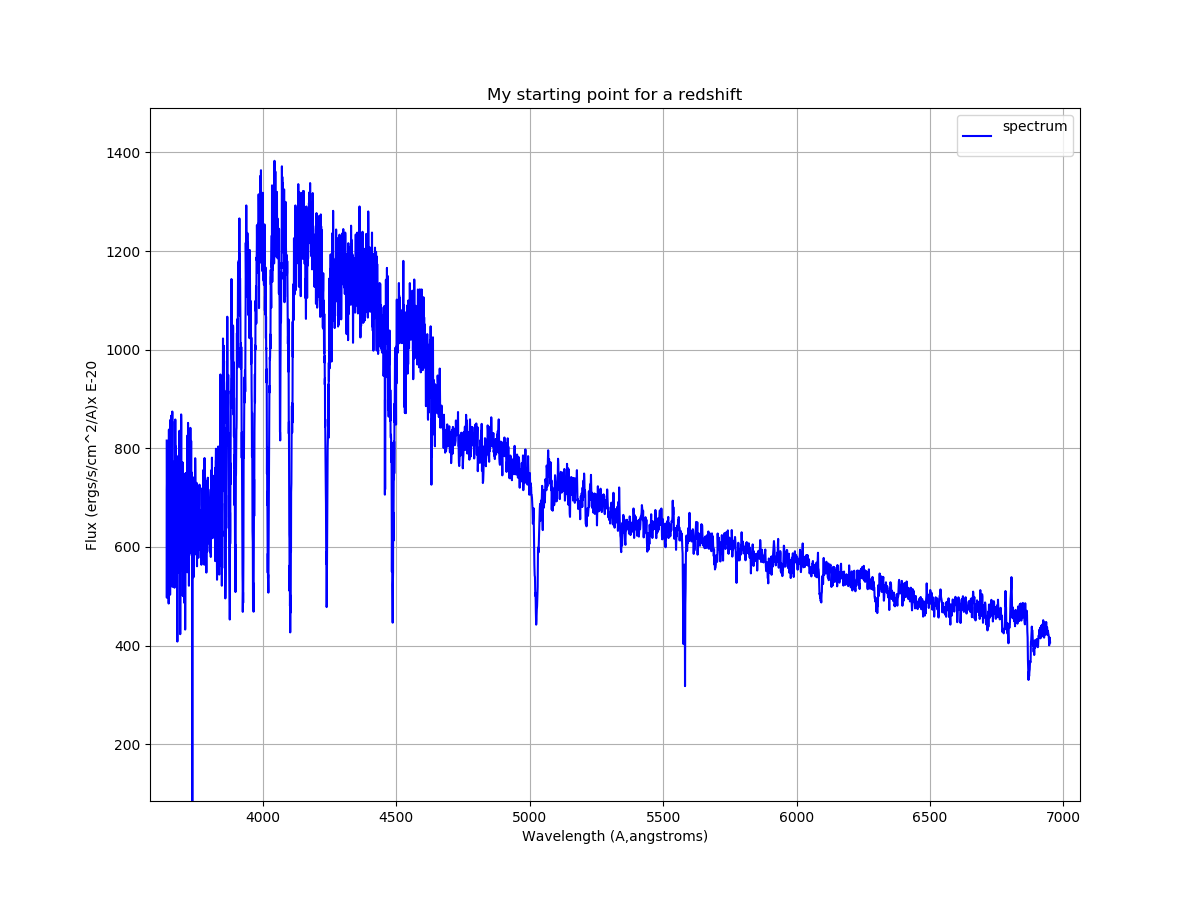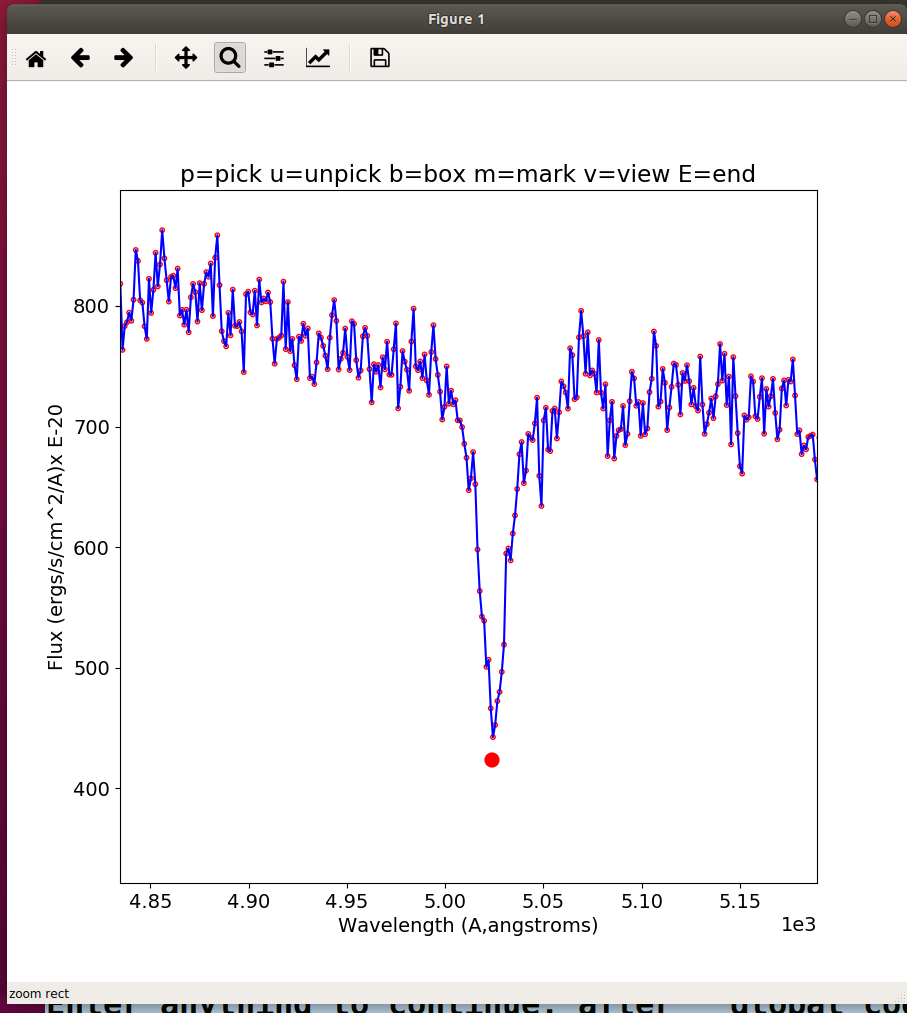Computing a redshit: Example 1
Updated: Aug05,2020
My input spectrum is assumed to be in the form of a table (i.e. the
files spectrum.table and spectrum.parlab). Just as an illustaration, I plot the
spectrum with my xyplotter_auto routine.
I do this work in: /home/sco/jimiL/reduce_jul25_2020/Aug05_1
% cat spectrum.parlab
wave Wavelength (A,angstroms)
flux Flux (ergs/s/cm^2/A)x E-20
fs Flux (ergs/s/cm^2/A)x E
% head -7 spectrum.table
# col01: wavelenght in units of angstroms
# col02: flux in units of ergs/s/cm^2/A x E-20
# col03: flux in standard scientific notation, ergs/s/cm^2/A
# data
3640.00 815.631592 0.81563152E-17
3640.49 497.090759 0.49709076E-17
3640.97 716.425720 0.71642576E-17
% Generic_Points N
% cat xyplotter_auto.pars
PointType L
PointColor b
LegendName spectrum
SymbolType -
Psize 5
% xyplotter_auto spectrum wave flux 1 N
 |
Above we see a 1-D spectrum from the UV and Orange channels of LRS2-B taken on
20200529 UT of 1 Zw 136 (Ra,Dec = 16:13:30.19 +51:03:35.6). I am going to guess
that the absorption line little redder than 5000 angstroms is H_beta. I could
"eyeball" from this plot an observed wavelength (Wo) for this line of about
5050 angstroms. Using the implotlib show() option to display the plot I
can get a better estimate of 5023.9 angstroms. With a rest wavelength (Wr)
of 4861.330 angstroms for H_beta we could then estimate a crude radial velocity:
% cat dat.1
5023.9 4861.330 H_beta_L
% redshift.sh dat.1
% cat redshift.out
Initial velocity values:
Wave_obs Wave_rest Feautre Vobs(km/s)
5023.900 4861.330 H_beta_L 10025.5
Mean Velocity = 10025.473 -+ 0.000
The formula we used was just:
v/c = (Wo - Wr) / Wr , where c is the speed oc light
v/c = (5023-4861)/4861 = 0.0333
v = 0.033 * 299792 km/sec = 9983.1 km/sec (or about 10,000 km/sec)
A lot of folks, especially people dealing with very distant HST-observed galaxies,
will use the value of v/c directly. They will refer to this as the redshift, z. Hence, in
our simple calculation here using one identified line we would assign a redshift for 1 Zw 136
of z = 0.033. But what about all those other lines? Can we identify them
and use them to compute a more reilable redshift?
|
Note that I could also have used the routine spec_selector
to view the spectrum and mark the suspected H beta line with an interactive cursor. The resultant
observed wavelength will then be written to a local file named "XY.Mark". Below I show an example
of this.
 |
Here I plot the same spectrum as above, but I have used "spec_selector" to plot
the spectrum with small red dots connected by blue lines. I zoom in on my suspected
H beta line and mark its position with the "m" key:
% spec_selector spectrum wave flux N
% cat XY.Mark
5024.411 440.852 m
The big red dot indicates where I marked the observed wavelngth position of the line.
The value we get for our observed wavelength is 5024.4 angstroms, and this agrees
with our previous "spitballing" estimte above.
|
The trick now is to assenble a script or routine that will allow us to run
spec_selector repeated times, identifying multiple spectral features. As
we identify more features we can compute mean radial velocity values to
improve our mean value or to identify unrecognized lines in the spectrum.
I can make a list of spectral lines that might be present in my spectrum.
% speclines.sh ALL 3700.0 7500.0 N
% cat speclines.out
3727.000 OII_3727
3934.000 CaII_K
3968.000 CaII_H
4101.740 H_delta
4160.000 CN1_L
4227.000 Ca4227_L
4305.000 G_band_L
4340.470 H_gamma
4383.000 Fe4383_L
4455.000 Ca3355_L
4471.500 HeI_4471
4531.000 Fe4531_L
4668.000 Fe4668_L
4685.680 HeII_4685
4861.330 H_beta_L
4958.910 OIII_4958
4921.900 HeI_4922
5006.840 OIII_5007
5015.000 Fe5015_L
5176.000 Mg_b_L
5198.500 NI_5198
5270.000 Fe5270_L
5335.000 Fe5335_L
5406.000 Fe5406_L
5709.000 Fe5709_L
5754.640 NII_5754
5782.000 Fe5782_L
5875.640 HeI_5876
5893.000 Na_D_L
6300.300 OI_6300
6312.100 SIII_6312
6363.780 OI_6363
6548.030 NII_6548
6562.820 H_alpha
6583.410 NII_6583
6678.150 HeI_6678
6716.470 SII_6716
6730.850 SII_6730
7065.280 HeI_7065
7135.780 ArIII_7136
5577.339 OI_5577sky
3750.150 H12
3770.630 H11
3797.900 H10
3835.390 H9
3889.050 H8
3970.070 Hepsilon
6867.200 B_fraun_O2
6276.600 a_O2_6277
Holy moly, that is a lot of lines!
To get a redshift we can use this procedure.
To just get a simple estimate of Vrad:
% cat dat.1
5023.9 4861.330 H_beta_L
usage: redshift.sh dat.1 [-v] [-h]
arg1 - input file listing Wave_obs, Wave_rest, Feature_Name
Additional options:
-v = print verbose comments and run in debug mode
-h = just show usage message
% redshift.sh dat.1
10025.473 0.000 (MeanVelocity,m.e.)
To mark a lot of lines and use them:
% spec_selector spectrum wave flux N
Usage: spec_selector margdist_sub pixel mean N
arg1 - basename of the table file ("Phot_Data" for Phot_Data.table)
arg2 - parameter name for X axis
arg3 - parameter name for Y axis
arg4 - run in debug mode? (Y/N)
**** Make the file XY.Mark
% redshifter.sh speclines.out 10025.5 -m XY.Mark
usage: redshifter.sh lines.1 29800.0 [-v] [-h] [-m ]
arg1 - input file listing: Wave_rest, Feature_Name
arg2 - radial velocity in km/s
Additional options:
-v = print verbose comments and run in debug mode
-h = just show usage message
-m = name of a marker file (like XY.Mark from speclines_id.sh) if available
Example: redshifter.sh speclines.out 10040.800 -m XY.Mark
*** This makes a table named redshifter.table
To get a final table of data for just the lines with identifications and then
compute final statistics we can follow this procedure:
To get a table of just those lines with identified lines:
% cat rules.1
vrev fpr -10 30000.0
% table_mask_builder redshifter rules.1 B0 N
10 final_number
To get the stats:
% table_stats.sh B0 vrev none N
% table_stats.sh B0 vrev none N
10013.32 10012.75 68.60 22.86 9887.05 10122.78 9 (mean,median,sigma,m.e.,min,max,N)
I could also use stats_outliers.sh to reject points
Back to calling page

